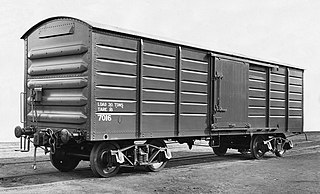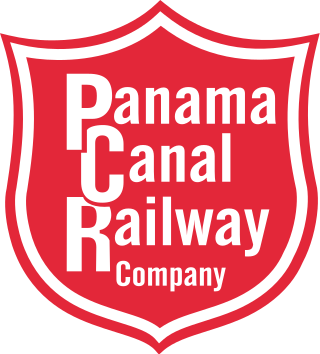
A railroad car, railcar, railway wagon, railway carriage, railway truck, railwagon, railcarriage or railtruck, also called a train car, train wagon, train carriage or train truck, is a vehicle used for the carrying of cargo or passengers on a rail transport network. Such cars, when coupled together and hauled by one or more locomotives, form a train. Alternatively, some passenger cars are self-propelled in which case they may be either single railcars or make up multiple units.

A boxcar is the North American (AAR) and South Australian Railways term for a railroad car that is enclosed and generally used to carry freight. The boxcar, while not the simplest freight car design, is considered one of the most versatile since it can carry most loads. Boxcars have side sliding doors of varying size and operation, and some include end doors and adjustable bulkheads to load very large items.

The Panama Canal Railway is a railway line linking the Atlantic Ocean to the Pacific Ocean in Central America. The route stretches 47.6 miles (76.6 km) across the Isthmus of Panama from Colón (Atlantic) to Balboa. Because of the difficult physical conditions of the route and state of technology, the construction was renowned as an international engineering achievement, one that cost US$8 million and the lives of an estimated 5,000 to 10,000 workers. Opened in 1855, the railway preceded the Panama Canal by half a century; the railway was vital in assisting the construction of the canal in the early 1900s. With the opening of the canal, the railroad's route was changed as a result of the creation of Gatun Lake, which flooded part of the original route. Following World War II, the railroad's importance declined and much of it fell into a state of neglect until 1998, when a project to rebuild the railroad to haul intermodal traffic began; the new railroad opened in 2001.
The Somerset Railroad was a railroad that operated in Niagara County, New York. It was operated by CSX Transportation. The railroad was built with the primary objective of providing coal to the Kintigh Generating Station, also known as the Somerset Power Plant, a 675 megawatt coal-fired power plant located in Somerset, New York. The railroad was built in 1983 by the New York State Electric and Gas Co. using new and old rights of way. From Lockport, New York, it runs on the defunct International Railway Co. (IRC) interurban line opened in 1900 under the name Buffalo, Lockport & Olcott Beach (BL&OB) which became part of the IRC in 1902. From Newfane, New York, the SOM sweeps off the IRC to the Hojack Line in Appleton, New York, to West Somerset in the Town of Somerset. It then swings off on new trackage to a series of spurs and a loop at the Kintigh Generating Station.

A tank car or tanker is a type of railroad car or rolling stock designed to transport liquid and gaseous commodities.

A hopper car (NAm) or hopper wagon (UIC) is a type of railroad freight car that has opening doors or gates on the underside or on the sides to discharge its cargo. They are used to transport loose solid bulk commodities such as coal, ore, grain, and track ballast. Plastic pellets and some finely ground material, similar to flour, are transported in hopper cars that have pneumatic unloading. The bottom gates on the pneumatic hoppers connect to a hose attached to industrial facilities' storage tanks. Air is injected to fluidize the railcar contents for unloading. The hopper car was developed in parallel with the development of automated handling of such commodities, including automated loading and unloading facilities.

A bulk carrier or bulker is a merchant ship specially designed to transport unpackaged bulk cargo—such as grain, coal, ore, steel coils, and cement—in its cargo holds. Since the first specialized bulk carrier was built in 1852, economic forces have led to increased size and sophistication of these ships. Today's bulk carriers are specially designed to maximize capacity, safety, efficiency, and durability.
The Kennebec Central Railroad was a 2 ft narrow gauge railroad operating between Randolph and Togus, Maine. The railroad was built to offer transportation for American Civil War veterans living at Togus to the nearby City of Gardiner. Tracks of 25-pound steel rails ran five miles from Randolph, Maine to the veterans home at Togus. Train service began on 23 July 1890.

A rotary car dumper or wagon tippler (UK) is a mechanism used for unloading certain railroad cars such as hopper cars, gondolas or mine cars. It holds the rail car to a section of track and then rotates the track and car together to dump out the contents. Used with gondola cars, it is making open hopper cars obsolete. Because hopper cars require sloped chutes in order to direct the contents to the bottom dump doors (hatches) for unloading, gondola cars allow cars to be lower, thus lowering their center of gravity, while carrying the same gross rail load. Cars are equipped with rotary couplers to allow dumping them while they are still coupled; a "Double Rotary" gondola or hopper has rotary couplers on both ends to allow it to be unloaded while it remains coupled to stationary cars at each end.

Rail freight transport is the use of railways and trains to transport cargo as opposed to human passengers.

Bulk cargo is commodity cargo that is transported unpackaged in large quantities.

Type H Tightlock couplers are a variety of Janney coupler, typically used on North American mainline passenger rail cars. They have mechanical features that reduce slack in normal operation and prevent telescoping in derailments, yet remain compatible with other Janney types used by North American freight railroads.

Coil cars are a specialized type of rolling stock designed for the transport of rolls of sheet metal, particularly steel. They are considered a subtype of the gondola car, though they bear little resemblance to a typical gondola.

SS William A. Irvin is a lake freighter, named for William A. Irvin, that sailed as a bulk freighter on the Great Lakes as part US Steel's lake fleet. She was flagship of the company fleet from her launch in the depths of the Great Depression in 1938 until 1975 and then was a general workhorse of the fleet until her retirement in 1978.

The Ralston Steel Car Company operated in Columbus, Ohio, from 1905 to 1953. The company began by modifying wood freight cars to add steel underframes. Later it manufactured its own line of all-steel rail cars.

An ore dock is a large structure used for loading ore onto ships, which then carry the ore to steelworks or to transshipment points. Most known ore docks were constructed near iron mines on the upper Great Lakes and served the lower Great Lakes. Ore docks still in existence are typically about 60 feet (18 m) wide, 80 feet (24 m) high, and vary from 900 feet (270 m) to 2,400 feet (730 m) in length. They are commonly constructed from wood, steel, reinforced concrete, or combinations of these materials.

An open wagon forms a large group of railway goods wagons designed primarily for the transportation of bulk goods that are not moisture-retentive and can usually be tipped, dumped or shovelled. The International Union of Railways (UIC) distinguishes between ordinary wagons and special wagons (F/6). Open wagons often form a significant part of a railway company's goods wagon fleet; for example, forming just under 40% of the Deutsche Bahn's total goods wagon stock in Germany.
The Victorian Railways in Australia have had a vast range of hopper-type wagons over the last century, for transporting various types of free-flowing dry goods including grains, fuel, and various powders.

JSC "Vostochny Port" is the largest stevedoring company in Russia, specialising in coal transshipment using automated conveyor equipment. The level of automation of operations is 100%. The port's main cargo is coal mined in Kuzbass, Eastern Siberia and the Far East. More than 99% of cargo is exported, primarily to countries in the Asia-Pacific region which include mainly South Korea, Japan, and China. It is the largest coal terminal in Russia. In 2016, the company shipped 23.5 million tonnes of coal, which is about 30% of the Far East ports' cargo turnover and about 20% of the cargo turnover of all coal ports in Russia. The sole executive body of JSC "Vostochny Port" is "Managing Port Company", LLC.



















